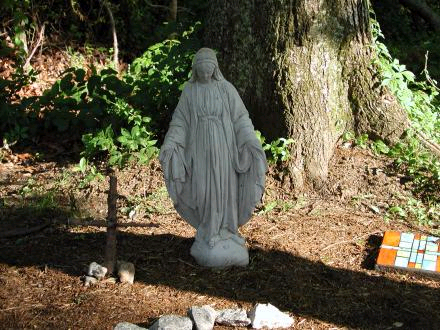Lady Asherah of
the Sea

(Image Courtesy of Jonathon Earl Bowser)
Lady Asherah of the Sea is the chief goddess of the Canaanite pantheon.
The earliest archeological evidence of Her existence begins in the 14th and
13th centuries in both Israel and Egypt. She was known as the Mother
of Creation, Mother of God, Queen of Heaven and nurturer of the pharaohs.
In earlier eras, Asherah was often associated with Venus (Greece), Hathor
(Egypt), Astarte and Ashtoreth (both of Phoenicia). In later times,
She is associated with Mary of Nazareth and Miriam of Magdala. Miriam
of Magdala may have been one of Her priestesses, as evidenced by her title
“The Woman with the Alabaster Jar” – a reference to the unguents often administered
by priestesses during burial in the name of the Goddess.
Asherah was later recognized as the consort or counterpart of El, whose
domain was the heavens. Asherah’s domain was the sea. As such,
my personal associations for Her include the colors blue and green and the
stone aquamarine. As the Lady of the Sea, She is associated with the
element of water. As Mother of God, She is associated with lions.
As a fertility goddess, She is associated with serpents and unleavened bread.
She ruled the harvest, grain and fertility. She was connected with
the life cycle, and was worshipped by women during menarche, sexual initiation,
marriage, birth and death.

(Image Courtesy of JBL Statues)
In Israelite culture, Asherah was most often represented as a small statuette
with a pillar shaped body, short, corkscrew curls and prominent breasts.
Wooden poles and stone pillars were set up near altars to Her. Many
times She was worshipped in a sacred grove or near a living tree as a representation
of Her. The pillars, a phallic symbol, figure in Her worship as praise
to regeneration and fertility. Her rituals often included the making
of bread, which was offered to the goddess as part of the following ritual,
outlined by Elinor Gadon:
“First the children gather wood and the fathers light the fire.
Then the women knead dough and make cakes that are baked over the fire.
When the preparations are completed, the women, assisted by the men, burn
incense and pour out libations to Asherah and the other Gods as well.”
In honor of Asherah, I located a “sacred grove” in my backyard.
The spot was especially appropriate for me, as there is a huge oak tree
standing in my personal direction (South) that is flame-red in the Fall.
I laid a spiral of rocks, with the final rock looking like the head of a
coiled serpent. There are two seahorse birdbaths at the entrance, to
represent the sea and pillars. I have a statue that represents her
priestess, Mary Magdalene. Most would recognize this statue as The
Virgin Mary. However, she is standing on a snake with an apple in her
mouth. To me, she is a representation of the survival of the Goddess.
The Spiral Garden is constantly changing, as my comprehension develops.
What originally was a dedication to Asherah is becoming more than that.
But She will always have a special place in my soul for choosing me and setting
me on my path.
(Images Courtesy of Rhianna’s Digital
Camera Wizardry)
Sources of Information:
The Art of Jonathon Earl Bowser at http://www.jonathonart.com/intro.html
The Gospel of Mary Magdalene by Jean-Yves Leloup
The Hebrew Goddess by Raphael Patai
JBL Statues at http://jblstatue.com/
The Once and Future Goddess by Elinor W. Gadon
The Woman with the Alabaster Jar by Margaret Starbird
When God Was a Woman by Merlin Stone
Yahweh’s Wife by Arthur Frederick Ide
This webpage is the intellectual property
of Kimberly.
Copyright 2004






